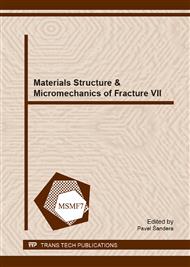p.745
p.749
p.753
p.757
p.761
p.765
p.769
p.773
p.777
Role of Microstructure on Fracture Behavior of T91 Steel in Presence of Liquid Sodium
Abstract:
The sensitivity to liquid sodium embrittlement (LME) of T91 martensitic steel, one of the selected structural materials for future sodium fast reactors has been investigated. The study took into account the role of microstructure. Small punch tests and three points bending tests were carried out in a purified and controlled atmosphere. Precipitation state and dislocations structure resulting from a tempering at 550° C provoked LME of the T91 steel between 200 and 550 °C. Secondary Ions Mass Spectroscopy investigation suggested that sodium penetration at prior austenitic grains boundaries promoted by plastic deformation occurred and caused brittle crack initiation. Brittle cracks propagated in sodium preferentially along martensitic laths-boundaries. J integral calculations confirmed a drop in toughness of T91 tempered at 550°C by liquid sodium up to 80 %.
Info:
Periodical:
Pages:
761-764
Citation:
Online since:
November 2013
Authors:
Price:
Сopyright:
© 2014 Trans Tech Publications Ltd. All Rights Reserved
Share:
Citation:


